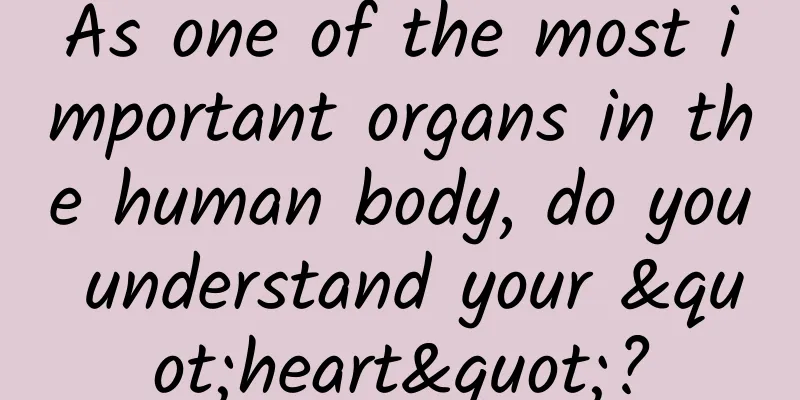As one of the most important organs in the human body, do you understand your "heart"?

|
Everyone knows that the heart is one of the most important organs in the human body. It provides power to our bodies at all times and allows us to fully experience the heartbeats, happiness, and heartaches in the world. But apart from these, do you really understand your heart? When you are hungry, your stomach will tell you to eat. When you are full, your bladder will remind you to go to the bathroom. When you are thirsty, your mouth will ask you to drink water. The heart is the engine of our life. It beats when you are awake and it still beats when you are asleep. You may even forget its existence. It is not good at expressing and confiding. If the owner does not know how to take care of it, it can easily get injured, sick, or even kill people without their knowledge. At present, cardiovascular disease has become the number one killer threatening human health. Each of us needs to understand it and take care of it. Let’s first get to know the heart. Image source: Wikipedia A normal heart is located on the left side of our chest cavity. It is about the size of our fist and shaped like a peach. Its internal structure is just like our ideal small villa, with two rooms upstairs, two rooms downstairs, two walls, four doors, two entrances, and two exits, which are what we often hear when doing cardiac ultrasound examinations: left and right atria, left and right ventricles, atrial septum, ventricular septum, the aorta connecting to the left ventricle, the pulmonary artery connecting to the right ventricle, and the mitral valve, tricuspid valve, aortic valve, and pulmonary valve that communicate between the atria, ventricles, and aortas. How did this house become the engine of our life? The heart also has a set of advanced circuits that control the heartbeat. The oxygenated blood in the lungs returns to the left atrium and left ventricle through the pulmonary veins and enters the aorta to supply oxygen and nutrients to all organs in the body. The consumed unoxygenated blood then returns to the right atrium through the superior and inferior vena cava, along the right ventricle and pulmonary artery to the lungs for reoxygenation, and the cycle repeats. The blood supply of the myocardium itself is completed by the coronary arteries. If there is a problem in any link, different heart diseases will be formed. If there is a problem in any part of this villa, different heart diseases will be caused. How to prevent and identify them early is our concern. Common heart diseases include congenital heart disease, hypertension, coronary heart disease, valvular disease, cardiomyopathy, etc. Congenital heart disease, as the name implies, occurs during the fetal period. The structure of the house was abnormal during its initial construction. Currently, the incidence of congenital heart disease is as high as 1%. The cause is still unclear, and it is generally believed to be the result of the interaction between genetic factors and environmental factors (viral infection in early pregnancy, folic acid deficiency, diabetic mothers, etc.). Image source: Photo Network There are many types of congenital heart disease. The most common ones in children are ventricular septal defect and atrial septal defect, which is what people often call a hole in the heart. People with large holes will experience feeding difficulties, recurrent pneumonia, growth retardation and even heart failure in infancy and childhood, and need surgery as soon as possible. People with small holes may have no obvious symptoms. Some will close naturally in infancy, while others will continue into adulthood, pregnancy and even old age, and will not be discovered until chest tightness occurs. There is also a type of complex congenital heart disease, also called cyanotic congenital heart disease . Children with this disease will show signs of hypoxia such as cyanosis and shortness of breath after birth, and need to be corrected surgically as soon as possible. Once a heart murmur is detected or there are suspicious symptoms and signs, it is recommended to undergo a cardiac ultrasound as soon as possible and visit a pediatric cardiologist to choose the best treatment plan. Fortunately, the rapid development of fetal cardiac ultrasound allows us to detect heart abnormalities through ultrasound probes before birth or even in early pregnancy. The integrated management model of mother and fetus can help with early prevention, early diagnosis and timely treatment of congenital heart disease. In addition, the heart has a special structure called the foramen ovale, which is open during the fetal period and closes after birth. About 1/4 of the population fails to close. More and more studies have found that unexplained cerebral infarction and headaches are related to patent foramen ovale. When the right atrial pressure increases (such as straining to defecate, coughing, and diving), thrombi or air emboli or primary emboli at the foramen ovale can enter the left heart and cause brain symptoms. This is what is often said recently that "brain" disease should be treated with "heart", and the culprit is this small-mindedness. It is not easy to find with conventional echocardiography, and the diagnosis can be confirmed by transesophageal ultrasound or right heart acoustic angiography. With the improvement of living standards and the increase of social pressure, hypertension is becoming more and more common and has become the biggest enemy of our health. In addition to genetic factors, high salt and high fat in the diet, drinking, smoking, mental stress, obesity and sleep apnea are all factors that cause it. Image source: Photo Network Of course, hypertension should exclude kidney, renal artery, thyroid disease, etc. Some young people's high and low hypertension was found to be caused by pheochromocytoma, which was cured after the tumor was removed. Hypertension can cause cerebrovascular disease, heart failure, coronary heart disease, aortic dissection and other target organ damage. Especially in winter, when it is cold, there are more patients with hypertension and more patients seeking emergency dissection. Aortic dissection is an urgent emergency and a disease with a very high mortality rate. Severe tearing and knife-like chest pain, if you have hypertension in the past, you must think of this disease. Once the aortic intima is torn, the affected organs will suffer from ischemia, blockage of the coronary artery orifice can cause myocardial infarction, and rupture can cause cardiac tamponade. Therefore, controlling blood pressure is urgent and will benefit you for life. Hypertension, hyperlipidemia, hyperglycemia, obesity and smoking have led to an increasing number of coronary atherosclerotic heart diseases, coronary artery sclerosis, stenosis or occlusion, causing myocardial ischemia, hypoxia or necrosis. The main clinical symptom of coronary heart disease is angina pectoris, but the manifestations are diverse. Typical angina pectoris occurs during activities or emotions, and is located in the middle and lower part of the sternum. The squeezing pain can radiate to the neck, shoulders, upper limbs or back, and lasts for several minutes to half an hour. It should be noted that many times the symptoms of angina pectoris are not typical and can occur during rest, manifested as chest tightness, shortness of breath, and sometimes misdiagnosed as frozen shoulder, toothache or stomach disease. Image source: Photo Network When acute coronary artery occlusion occurs, it can lead to acute myocardial infarction, which is also the most common cause of sudden death in the general population. Treatment includes minimally invasive interventional therapy with stent placement or coronary surgery. A proper diet, a certain amount of physical activity, quitting smoking and limiting alcohol consumption, and losing weight are particularly important for preventing coronary heart disease. If the heart is the engine, then the myocardium is the material of the engine. The better the myocardium, the higher the quality of the engine. The main types of cardiomyopathy include dilated cardiomyopathy, hypertrophic cardiomyopathy and restrictive cardiomyopathy. The cause of cardiomyopathy is usually unclear, either inherited or acquired. Certain health conditions or behaviors that may lead to acquired cardiomyopathy include: long-term high blood pressure, long-term arrhythmias, valve problems, viral infections, metabolic disorders, chemotherapy and radiotherapy, excessive drinking, vitamin B-1 deficiency, pregnancy complications, abnormal protein accumulation in organs (amyloidosis), etc. Cardiomyopathy may not cause any signs or symptoms in the early stages. But signs and symptoms usually appear as the disease progresses, including symptoms of heart failure such as dyspnea and edema during activity or rest. In addition, there are some special viruses that can invade the respiratory tract and cause colds, and can also damage the myocardium. Mild cases may cause palpitations and fatigue, while severe cases may cause heart failure, syncope, and even sudden death, also called fulminant myocarditis. If you have a cold, you must rest well, and in the absence of knowing what virus it is, we must protect our hearts from being invaded. There are also two special cardiomyopathies that are easily misdiagnosed as myocardial infarction, one is stress cardiomyopathy, and the other is apical hypertrophic cardiomyopathy. As the saying goes, anger hurts the body. The heart can also be inflated by anger. Stress-induced heart disease is common in women. It is caused by huge mental stimulation, sudden chest pain, long duration, and even coma. Acute myocardial infarction is often diagnosed, but no obvious stenosis is found in coronary angiography. Therefore, it can be seen that the regulation of the human body by neuroendocrine is beyond imagination. Sympathetic hyperactivity causes the apex of the left ventricle to swell into a balloon shape, and the left heart function decreases, which often takes weeks and months to return to normal. Apical hypertrophic cardiomyopathy is often easily missed. The electrocardiogram of such patients often indicates myocardial infarction. More than 20 years ago, a patient had a physical examination after graduating from university. The electrocardiogram indicated acute myocardial infarction and an ambulance was called. The doctor was very nervous in every subsequent physical examination, but no abnormalities were found in other examinations. In fact, an echocardiogram can be performed on the apical short-axis section to see apical hypertrophy. Echocardiography can diagnose and differentiate different types of cardiomyopathy. The valve is the gate of the heart. Problems with the heart valve can lead to stenosis or incomplete closure. In Dream of the Red Chamber, Lin Daiyu died of coughing up blood. According to the signs of "red cheeks", "out of breath after taking one more step", "insomnia at night, sitting up to breathe", it is consistent with mitral stenosis and left heart failure. If there was an echocardiogram at that time, the truth would be revealed. This type of disease is most common in rheumatism and degenerative lesions. The treatment can currently be surgical open-chest mechanical or biological valve replacement or non-open-chest minimally invasive interventional treatment. In recent years, the success rate of surgical valve repair has also increased year by year, allowing damaged valves to be rejuvenated. Speaking of echocardiography, it has played an indispensable role in the accurate diagnosis and treatment of heart disease. Transthoracic echocardiography, transesophageal echocardiography, three-dimensional echocardiography, right heart acoustic angiography and other examinations can clearly explore the structure and function of the heart in multiple dimensions, in real time, and are easy to operate and non-invasive, making them the first choice for heart examinations. The diagnosis and treatment of heart disease is inseparable from echocardiography. Currently, cardiac surgeons and cardiologists need first-hand information from echocardiographers. Echocardiography can be called the sharp eyes of heart doctors. With the development of computer and ultrasonic imaging technology, echocardiography, as one of the medical imaging technologies, plays an increasingly important role in clinical diagnosis and treatment. Now that you know the structure of the heart, the diagnosis and treatment of common heart diseases, and the vital value of echocardiography, do you understand your heart? The heart is the engine of life, so we must take good care of it. Eat healthily, increase exercise, control weight, quit smoking and limit alcohol consumption, be optimistic and open-minded, have regular physical examinations, and take care of your heart. Start now! Author: Chongmei Beijing Anzhen Hospital affiliated to Capital Medical University Deputy Chief Physician of Cardiac Ultrasound Center |
<<: Sound really can travel through a vacuum! It's time to rewrite your physics textbook
Recommend
Spring Responsive Programming Practice
Spring responsive programming practical resources...
Apple’s color philosophy: Is gold really made for Asia?
Apple first launched the gold iPhone 5s, then the...
Meizu MX4 Pro first experience: what can you get for spending an extra 700 yuan?
Meizu MX4 Pro is here, it is the second phone lau...
Coffee + alcohol = double the carcinogens? Here comes the September science rumor list →
1. If you use "traditional remedies" su...
As a WeChat operator, you can’t possibly not know these…
"How well do you understand WeChat official ...
Why do you look ugly in the camera of your mobile phone? 3 ways to make you look as good in the video as in real life
Exploiting a bug in the phone's camera. When ...
Marketing must-read: Limited-time flash sales operation and influencing factors
Limited-time flash sales are a marketing applicat...
How to upload APP software to the Android App Store
Currently in the domestic software market, the va...
How to earn 2 million in 7 days through social media marketing?
Let me share with you some of my practical commun...
A review of the auto industry executives who have fallen in the past three years: state-owned enterprises are the hardest hit, and there are also many new forces
Recently, Chen Hao, the former deputy general man...
B station places advertisements, and the forms of B station advertisement display
Some time ago, Bilibili released its Q3 financial...
An introduction to Yidian Zixun platform and a display of advertising cases!
Platform Introduction Yidian Zixun is an interest...
The sales data analysis ideas you must sort out before "Double 11"
The case is this: An e-commerce company that sell...
Can you keep the cute "jade rabbit" in the sea? I advise you to hold back!
⚠Calendar Girl Front Row Reminder⚠ This article i...









